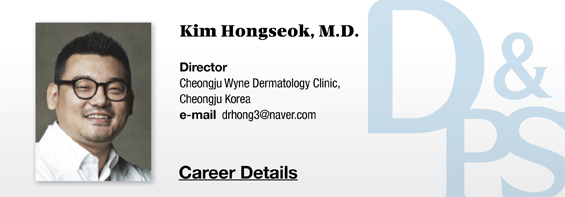
Kligman compared the number of micro comedone between treatments of 2% SA and 8% GA in women. GA did not have any impact on micro comedone but BHA showed a significant reduction7). Comparison of the effect of 30% SA and Jessner's solution on acne revealed little difference between two groups in terms of inflamed acne. However, 30% SA was more effective in improving non-inflamed acne[i]. A split-face study examined the effect of 30% GA and 30% SA peel in mild to moderate acne and found that acne improved in both groups. However, SA was more effective in acne due to its lipophilicity[ii].
BHA differs from AHA in that it does not require neutralization. Application of SA is followed by formation of frost. The frost forming after TCA application is caused by precipitation of protein. On the other hand, SA frost forms from precipitated SA substances. Reapplying TCA over the area without frost after first application is very risky as frost can form more slowly at lower concentrations. However, with SA, frost forms in about 2 minutes after application and can be reapplied on areas without frosting. It is easy to identify where the peeling agent should be reapplied by looking for areas without frosting. BHA does not require neutralization and can be applied over extensive areas in the torso but extensive application of SA is not recommended. Extensive exposure of areas of ichthyosis or damaged barrier to SA was reported to cause salicylism[iii]. Such cases can develop symptoms of salicylism such as vomiting, disorientation, and tinnitus. Many DUI facial products contain SA and American cleansers for acne-prone skin contain 0.5~2% of SA. In Korea, products can contain SA only up to 0.5%. Continuous use of these products can make the skin dry and sensitive but these problems are more common with higher concentrations. It is important to moisturize sufficiently after using BHA.
[Advertisement] MAGNUM(Q-switched Nd:YAG Laser) – Manufacturer: (www.i-dana.com)]
Resorcinol
Resorcinol was first introduced in 1882 by Unna and has been used as a chemical peel agent. Resorcinol (m-dihydroxybenzene) is a phenol extract with anti-pruritus, keratolytic, antifungal, and antibacterial actions. It is mainly used in pigmented and acne lesions. It is used in combination with other substances such as Jessner's solution, rather than alone. Topical application of 53% resorcinol once weekly for 10 weeks in 9 patients resulted in increased epidermal thickness by 0.03mm and 5 patients experienced increased elastic fibers[iv]. Exposing the entire body surface is risky due to potential toxicity and long-term exposure can weaken thyroid function and cause myxedema. Resorcinol is also used as moderate chemosensitizer and rarely causes allergic contact dermatitis. Resorcinol is particularly effective in the treatment of PIH but should be used with caution in Fitzpatrick skin type IV as it can cause PIH. It can reach deep into the skin or act as a moderate depth filler. Tretinoin can be used before treatment to increase the absorption of the filler.
Jessner's Solution
Jessner's solution was developed by Dr. Max Jessner and is created by adding resorcinol 14g, SA 14g, and lactic acid 14g in 95% ethanol for 100cc solution. This filler was concocted in the most ideal ratio for reducing toxicity and enhance efficacy of each component. Jessner peel does not require neutralization and can be used with other fillers. It can be used in melisma, acne, acne scare and other various conditions. A study examining combination of Q-switched Nd:YAG laser and Jessner's solution in melasma found that melasma significantly improved in the first 8 weeks but showed little difference after 20 weeks[v]. Combination can make the skin more sensitive and sufficient miniaturization is necessary. Comparison of 30% SA and Jessner's solution in epidermal melisma found similar results[vi]. Combining 20% TCA and Jessner's solution in acne scar was 60% more effective than 20% TCA alone[vii]. Jessner's solution is relatively safe, however, use in darker skin tones requires extra caution. Resorcinol is associated with a higher risk of PIH in a dark skin tone. Patients with Fitzpatrick skin type IV, in particular, can develop contact dermatitis from resorcinol.
[i] Bae BG, Park CO, Shin H, et al. Salicylic acid peels versus Jessner's solution for acne vulgaris: a comparative study. Dermatol Surg. 2013 Feb;39 (2):248-53.
[ii] Kessler E, Flanagan K, Chia C, et al. Comparison of alpha- and beta-hydroxy acid chemical peels in the treatment of mild to moderately severe facial acne vulgaris. Dermatol Surg. 2008 Jan; 34 (1):45-50; discussion 51.
[iii] Brubacher JR, Hoffman RS. Salicylism from topical salicylates: review of the literature. J Toxicol Clin Toxicol. 1996;34:431
[iv] Hernandez-Perez E, Carpio E. Resorcinol peels: gross and microscopic study. Am J Cosm Surg. 1995;12:337
[v] Lee DB, Suh HS, Choi YS. A comparative study of low-fluence 1064-nm Q-switched Nd:YAG laser with or without chemical peeling using Jessner's solution in melasma patients. J Dermatolog Treat. 2014 Dec;25 (6):523-8.
[vi] Ejaz A, Raza N, Iftikhar N, et al. Comparison of 30% salicylic acid with Jessner's solution for superficial chemical peeling in epidermal melasma. J Coll Physicians Surg Pak. 2008 Apr;18 (4):205-8.
[vii] Neerja Puri. Efficacy of Modified Jessner's Peel and 20% TCA Versus 20% TCA Peel Alone for the Treatment of Acne Scars. J Cutan Aesthet Surg. 2015 Jan-Mar; 8 (1): 42–45.
-To be continued-




















